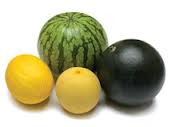Melon needs to germinate, grow and mature enough heat (bottom +12°C, ambient 20°C). In our climate, it‘s so only possible with the aid of hot beds or the greenhouse.
Watermelon (Citrullus vulgaris or C. lanatus) is the big brother with a smooth, green skin, sometimes with drawn design. The flesh is sweet, red, juicy. They are grown on the ground, they are too heavy for wires.
 The cantaloupe, honeydew melon (Cucumis melo) is (distant) family of cucumber.
The cantaloupe, honeydew melon (Cucumis melo) is (distant) family of cucumber.
Top the plant at 4 leaves, and keep the main rank of each armpit. Male flowers are by 3 or 4, and appear first, female standing separately and away from the main stem. They have an egg-shaped fruit.
Prune the rank at 2 leaves behind the fruit. Hold 4 or 5 melons per plant (or 10 small ones). Remove new axillary shoots. There are only fruits on the side shoots.
The Honeydew and Amarillo liso from Spain are called smooth melons, also honey or sugar melon.
Cantaloupe melons, named after a small village near Rome, are round or slightly flattened and on the outside divided into segments or covered with warty nodules. Well-known varieties are the Charentais or Cavaillon and Orange Pineapple.
Musk-melon as the Galia melon with emerald green flesh have corky brown or white mesh on the smooth or segmented shell.
Ogen melons are a cross between a cantaloupe and a type musk-melon.
Melons are ripe when you smell them, around the fruit stem then is a crack. Leave them for a day or three to ripen at room temperature. As with tomato you smell and taste that they could ripened at the bush.
Immature, small fruits can still be preserved as pickles at the end of the season.
